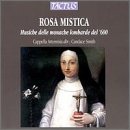| All Artists: Isabella Leonarda, Bianca Maria Meda, Chiara Margarita Cozzolani, Rosa Giacinta Badalla Title: Rosa Mistica Members Wishing: 0 Total Copies: 0 Label: Tactus Records Release Date: 9/12/2000 Genre: Classical Styles: Opera & Classical Vocal, Forms & Genres, Concertos, Historical Periods, Baroque (c.1600-1750), Early Music Number of Discs: 1 SwapaCD Credits: 1 UPC: 723723930224 |
Search - Isabella Leonarda, Bianca Maria Meda, Chiara Margarita Cozzolani :: Rosa Mistica
 | Isabella Leonarda, Bianca Maria Meda, Chiara Margarita Cozzolani Rosa Mistica Genre: Classical
|
Larger Image |
CD Details |
CD ReviewsWORTH EVERY PENNY! Stuart J. Herkenhoff | Globe, AZ United States | 11/30/2003 (5 out of 5 stars) "EVERY COMPOSITION ON THIS ALBUM IS A KEEPER. THE VOICES HARMONIZE IN THE MOST PLEASING WAYS; I NEVER GET TIRED OF LISTENING TO THESE MOST BEAUTIFUL FEMALE VOICES IN HARMONY. THIS IS ONE OF MY TOP LISTENING CHOICES. ORIGINALLY HEARD THIS ON A FM CLASSICAL STATION, AT NIGHT, WHILE THE MOUNTAINS BURNED ALL AROUND. STAYED UP LATE TO LISTEN AND GET THE INFORMATION SO I COULD GET THE MUSIC-SACRIFICED NEEDED SLEEP BUT IT WAS WORTH IT, EVERY MINUTE. YOU WILL NOT BE DISAPPOINTED IF YOU LOVE THE FEMALE VOICE...." Music in the Nunnery Giordano Bruno | Wherever I am, I am. | 06/06/2008 (5 out of 5 stars) "The impressive music on this CD was all written by cloistered and sequestered nuns in Italy in the 17th Century. Of the nine composers, only one, Chiara Margarita Cozzolani, has been given much attention in recent times, chiefly because of her more ample publications in her lifetime. Nuns often confronted opposition to their musical activities, aside from their liturgical duties of chanting the psalms every day at the appointed hours, from their male clerical superiors. More music by nuns of Milanese convents has survived chiefly because their archbishop, Federigo Borromeo (in office 1595-1631) was ardently supportive of their efforts. Almost certainly, the vast bulk of music composed and performed by nuns during the Baroque era has been irretrievably lost. Since many women entered the convent in their teens, much of the musical training they received came from older nuns; the "culture" of music in teh cloisters was self-perpetuating. Nonetheless, these compositions demonstrate that total sequestration did not prevent the nuns from knowing about and imitating the most current music of the secular world. The strictest clergy (male, of course) vehemently opposed the practice of instrumental music in the cloisters; nevertheless, nuns played the whole assortment of string, keyboard, and wind instruments of their times, even including cornetti and sackbuts. The latter have been documented in cloisters in Ferrara and Modena. It's hard for modern people to imagine why there could have been such suspicion directed against music in the cloisters, especially since all of the surviving examples are deeply religious and devotional in character. All but one of the selections on this CD are in Latin, and many are celebrations of the Virgin Mary. Indeed, it would seem that music was the strongest defense against a life of idleness, minor mischief, frivolity, and depression. Just such an image of largely wasted lives is presented in the book "Virgins of Venice" by Mary Laven, which I've recently reviewed. Here is a list of very fine CD performances of music by cloistered nuns of Baroque Italy: Cozzolani: Dialogues with Heaven (motets) performed by Musica Secreta Cozzolani: Vespro della Beata Vergine performed by Magnificat Cozzolani: Messa Paschale performed by Magnificat Lucrezia Vizzana: Componimenti Musicale 1623 performed by Musica Secreta This CD, Rosa Mistica, is performed by an ensemble of all women, both singers and instrumentalists. The instruments include organ, harp, gamba, and theorbo. One of the oddities of published music by nuns is that multi-voice motets include lines indicated for tenors and basses. Cappella Artemisia has addressed this problem in several ways - by transposition, by doubling the bass instrumentally, and by assuming that women did sing those lines, either at written pitch or at ottavo. This ensemble, as well as the smaller ensemble Musica Secreta, demonstrate the the lower registers of women's voices can be powerful and musically effective. Rosa Mistica is a beautiful performance of ardent music, not a mere novelty or apology for the repression of women in the patriarchal past. There's nothing repressed or frivolous about it." Stunning music, stunning performers Matthew Mendlik | Boston, MA, United States | 03/02/2009 (5 out of 5 stars) "It's hard to believe, but the church hierarchy of the 1600s (who evidently had a problem with nuns doing things other than breathing) actually tried to suppress their nuns' practice of music, at least the polyphonic kind. It's sad to imagine how they must have succeeded, and to think of what's been lost, but the collection presented on Rosa Mistica is nevertheless a broad and wonderful group of compositions by nuns who perhaps composed and performed despite the rules. The extensive liner notes present some details of the lives of these composers: some were lucky enough to be published and respected in their lifetimes, but many simply faded away. Thankfully their voices haven't.
Cappella Artemisia perform these pieces with incredible depth and emotion, and the sound is likely to be fresh and unique to the ears of many Early Music fans: compositions for SATB choirs would have been problematic for cloistered nuns who had no real Ts or Bs hanging around the convent, so the lower parts were often transposed up or doubled with low instruments for performances. Cappella Artemisia employs these techniques to produce a sound encompassing the complete range of the female voice. We can be thankful to those who composed despite discouragement, those who somehow preserved or re-discovered such precious music, and those who perform it, bringing it to our thirsty ears." |

 Track Listings (14) - Disc #1
Track Listings (14) - Disc #1